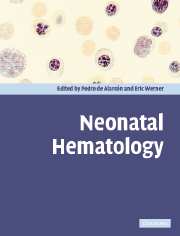Book contents
- Frontmatter
- Contents
- List of contributors
- Foreword
- Preface
- 1 Neonatal hematology: a historical overview
- 2 Disorders of the fetomaternal unit
- 3 Erythropoiesis, red cells, and the approach to anemia
- 4 Anemia of prematurity and indications for erythropoietin therapy
- 5 Hypoplastic anemia
- 6 Hemolytic disease of the fetus and newborn
- 7 Neonatal hemolysis
- 8 Neonatal screening for hemoglobinopathies
- 9 Polycythemia and hyperviscosity in the newborn
- 10 Newborn platelet disorders
- 11 Neutrophil function and disorders of neutrophils in the newborn
- 12 Immunodeficiency diseases of the neonate
- 13 Hemostatic abnormalities
- 14 Transfusion practices
- 15 Umbilical-cord stem-cell transplantation
- 16 Neonatal oncology
- 17 Normal values and laboratory methods
- Index
- References
13 - Hemostatic abnormalities
Published online by Cambridge University Press: 10 August 2009
- Frontmatter
- Contents
- List of contributors
- Foreword
- Preface
- 1 Neonatal hematology: a historical overview
- 2 Disorders of the fetomaternal unit
- 3 Erythropoiesis, red cells, and the approach to anemia
- 4 Anemia of prematurity and indications for erythropoietin therapy
- 5 Hypoplastic anemia
- 6 Hemolytic disease of the fetus and newborn
- 7 Neonatal hemolysis
- 8 Neonatal screening for hemoglobinopathies
- 9 Polycythemia and hyperviscosity in the newborn
- 10 Newborn platelet disorders
- 11 Neutrophil function and disorders of neutrophils in the newborn
- 12 Immunodeficiency diseases of the neonate
- 13 Hemostatic abnormalities
- 14 Transfusion practices
- 15 Umbilical-cord stem-cell transplantation
- 16 Neonatal oncology
- 17 Normal values and laboratory methods
- Index
- References
Summary
Introduction
Hemostatic abnormalities can be considered as either congenital or acquired and can be classified as hemorrhagic or thromboembolic disorders. In newborns, the clinical presentation, diagnosis, and management of hemorrhagic and thromboembolic disorders differ from those in older infants and children, likely reflecting profound differences of the hemostatic system at birth. While severe congenital hemostatic defects usually present in the first hours to days of life with distinct symptoms in otherwise well newborns, acquired hemostatic disorders usually present in sick newborns with a variety of presentations and distinct etiologies that differ from older children and adults. In newborns, the diagnosis of hemostatic abnormalities based upon plasma concentrations of components of the hemostatic system requires age-appropriate reference ranges, because plasma concentrations of several procoagulant and inhibitor proteins are physiologically decreased at birth. The aim of this chapter is to discuss the clinical presentation, diagnosis, and management of the most common congenital and acquired hemostatic disorders in newborns.
Hemorrhagic disorders
Congenital hemorrhagic disorders
General information
Hemostatic proteins
For congenital deficiencies of components of the hemostatic system, both a severe and a milder form occur. Severe congenital deficiencies of prothrombin, factor V (FV), factor VII (FVII), factor VIII (FVIII), factor IX (FIX), factor X (FX), factor Ⅺ (FXI), fibrinogen, factor XIII (FXIII) and alpha2-antiplasmin (α2AP) all can present with bleeding in the first days of life [1–4]. Mild congenital deficiencies of these proteins usually do not cause bleeding at birth in otherwise healthy full-term newborns.
- Type
- Chapter
- Information
- Neonatal Hematology , pp. 310 - 348Publisher: Cambridge University PressPrint publication year: 2005
References
- 7
- Cited by



